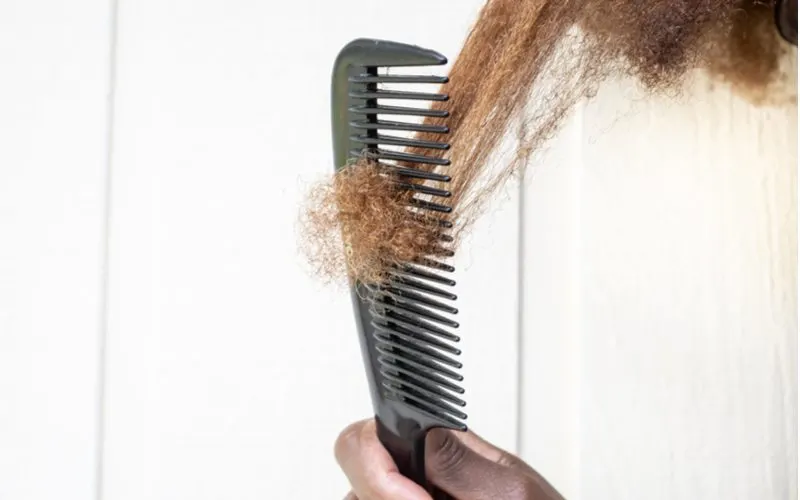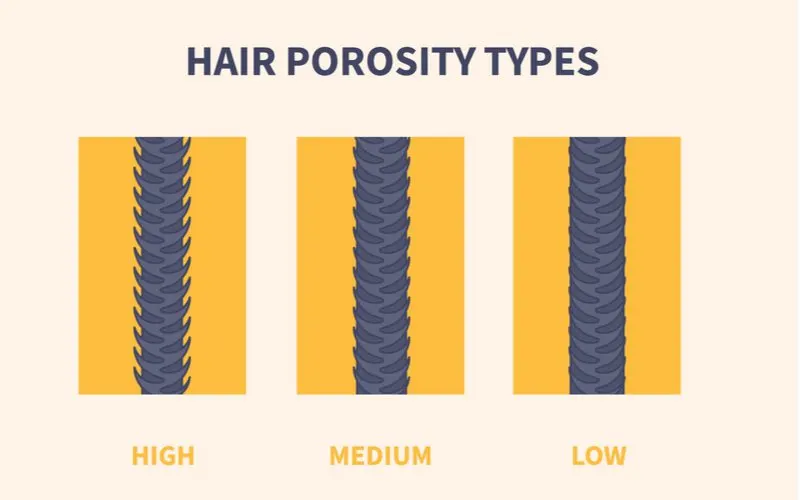Jump to:
Take our accurate hair porosity quiz to find out how porous your hair really is! Are you high, medium, or low porosity? How should you change your hair care routine? Don’t worry — we’ll show you this and more.
You Need a Hair Porosity Quiz. Here’s Why.
At You Probably Need a Haircut, we believe in getting to know your strands better. Learning about what your hair is – and what it isn’t – is key to coming up with a healthy, beneficial hair care routine.
Knowing your hair’s porosity level – how absorbent and porous it is – is key if you want to treat your mane right and have more good hair days. That’s why we’ve created the most accurate hair porosity quiz online.
Before you answer the 5 quick questions, let’s talk about hair porosity and why it matters.
Why Hair Porosity Is a Big Deal

CPcollins Photography/Shutterstock
Hair porosity is a big topic in the industry. For us non-professionals who are curious about our hair’s porosity level, online quizzes or DIY strand porosity tests have been our only options to find out how porous our strands are.
But many of the “tests” and quizzes that promise to tell you your hair’s porosity level once and for all are vague at best. Most of the hair porosity quiz results we analyzed online were completely wrong! So we created an accurate hair porosity quiz of our own.
Even if you think you know what your hair porosity level is, you need to take the quiz.
Your hair’s porosity level literally dictates what products, routines, and techniques are going to work for your hair. More importantly, it’ll help you start avoiding the practices and products that don’t work for your hair or are causing more harm than good.

art4stock/Shutterstock
The more porous your hair is, the faster it’ll drink up moisture – and lose it. The less porous your hair is, the harder it is for moisture and products to penetrate. You can see how knowing your porosity level becomes important for picking out the right hair products!
Maybe you’ve had a sneaking suspicion that you have high porosity hair – hey, that could be the reason your strands are always so thirsty and dry lightning fast – but haven’t been able to confirm it yet.
Maybe you’re thinking you have low porosity hair. That would definitely explain why protein masks and products seem to make your hair feel like brittle straw when others get soft, silky results from the same products!
Or you might be somewhere in the middle, with medium porosity hair that doesn’t repel or soak up water the way low and high porosity strands do.
Find out your hair porosity level right now with our accurate, fast quiz! Answer 5 easy questions about your hair below. We’ll show you if you have high, medium, or low porosity hair. You’ll also get personalized tips for your porosity level in your instant results!
Take Our Quick Hair Porosity Quiz
Do you have high, medium, or low porosity hair? Find out in less than a minute by answering these quick questions!
You Took the Quiz. Now What?
You know whether your hair is low, medium, or high porosity now. What’s next? Check out our tips for each porosity level and watch how quickly your hair responds to customized care!
Tips for Low Porosity Hair

Low porosity hair is like the Wonka factory in the “Nobody ever goes in…nobody ever goes out” era. Very little moisture and hair products actually manage to penetrate minimally-porous hair. But the silver lining is that this porosity level experiences very little moisture loss.
The moisture in low porosity hair sticks around for a while, making this hair type pretty resistant to dryness. Since low porosity hair takes a long time to let go of moisture, your hair likely takes a long time to fully dry.
That’s a positive sign that your hair isn’t losing much moisture, but it can be frustrating to deal with when you wake up with wet hair after showering at night.
Main Low Porosity Hair Concerns
- Buildup: Clarify with ACV
- Oiliness: Limit heavy moisturizers
- Protein Overload: Avoid protein-enriched products
The main issues with low porosity hair are buildup, oiliness, and protein overload (sensitivity to protein-enriched hair products).
You can fight buildup by clarifying low porosity hair once a week with clarifying shampoo or an apple cider vinegar rinse. This will strip remaining hair products, oil, and dirt away to leave your hair shiny, soft, and buildup-free.
Work around oily hair by limiting the heavy moisturizing products you use – they’ll just sit on top of your barely-porous hair anyway. Conditioner may be all the moisture you need.
Using it from your midshaft to ends in a warm shower will offer the best strand penetration. Since protein-enriched products help add protein to the hair strands and smooth the cuticle layer down, it can be a little too much on your already-smooth strands.
This leads to protein overload, which can make your hair feel stiff and straw-like. Skip any products with protein in the formula and see how much your hair texture and softness improves!
One final tip – pair any moisture you apply to your hair with a little heat. Heat temporarily nudges your hair’s outer cuticle layer open so products and moisture can better penetrate. Once you’re no longer applying heat, your cuticle layer lies back down and locks all that moisture in!
Tips for Medium Porosity Hair

Oleksandr Panasovskyi/Shutterstock
Medium porosity hair is like the socialite who gets along with everyone and constantly has people coming and going from her place. If you have medium hair porosity, your strands are letting plenty of water in and out for a nice moisture balance.
Your hair likely feels adequately hydrated without you going out of your way to provide moisture. The outer cuticle scales in medium porosity hair are slightly raised up.
It’s enough to allow a steady flow of moisture, oils, and nutrients without letting everything flood in or out at once. You’ve probably noticed that your hair doesn’t take long to air dry and only takes a minute or so to fully saturate in the shower.
Medium or normal hair porosity is a good thing and means your strands are doing their job on autopilot. But there are still a few concerns you’ll deal with if you have medium hair porosity.
Main Medium Porosity Hair Concerns
- Buildup: Clarify with ACV
- Moisture Loss: Condition with heat
Medium hair porosity means buildup and moisture loss are common issues.
Your hair’s cuticle layer is more “open” and raised than in low porosity hair, but the difference is slight. Your hair doesn’t absorb moisture and products quite as readily as high porosity hair, so what’s left on top of strands builds up over time and dulls your hair.
Working around the buildup issue is simple. Clarify to remove buildup weekly with clarifying shampoo or an apple cider vinegar rinse. Don’t put anything on your hair that won’t be fully absorbed!
This means steer clear of heavy moisturizers and oils (unless you’re pairing them with heat). Use minimal gels, creams, and lacquers on your hair to cut down on buildup.
Dealing with buildup doesn’t mean cutting out healthy moisture and hydration, though. Medium hair porosity needs a steady supply of moisture to retain. Condition your hair (let it sit for at least 5 minutes) in a warm shower to boost moisture penetration.
If conditioner alone isn’t enough, try a lightweight leave-in conditioner and use heat (hot towel, shower cap, heated conditioning cap) to drive it into your strands.
High Porosity Hair

Oleksandr Panasovskyi/Shutterstock
High porosity hair is like a gambler that spends their winnings as soon as they get them, but still ends up with a net loss. High porosity hair takes in moisture unbelievably fast, but loses it just as quickly.
This means hair with high porosity is chronically dry and fragile. High porosity hair has been damaged at some point. Chemicals, heat, and environmental factors can raise the pH of your hair high enough to lift the outer cuticle layer all the way up.
This “opens the floodgates” and allows water, oils, and nutrients to pour into your hair quickly.
But since those floodgates are open, everything your hair absorbs is quickly lost. This means you get no lasting hydration, even when you layer heavy products and sealing oils on your strands.
Main High Porosity Hair Concerns
- Excess Moisture Loss: Lower the raised cuticle
- pH Imbalance: Switch to low pH products
- Dryness: Heavy, protein-enriched moisturizing products
High hair porosity is synonymous with moisture loss. The only way to prevent excessive moisture loss is to make your hair less porous by lowering the pH.
Right now, the pH of your hair is likely on the high end. That’s why the outer cuticle layer is raised. You can fix this issue by switching to a low pH shampoo and doing weekly apple cider vinegar rinses to keep the pH low.
As your hair’s pH level gets lower, the cuticle layer will lie down and tighten up more to prevent excess moisture loss. If you haven’t yet, start using protein-enriched moisturizing products.
Hair masks, leave-ins, and conditioners containing hydrolyzed protein will strengthen and fortify your damaged hair. This will help it retain moisture better and resist breakage.
Try one of our top-recommended hair masks for damaged hair or mix up the protein-packed Cardi B hair mask to try!
While you work on balancing your hair’s pH and preventing excess moisture loss, avoid the worst sources of hair damage. Chemical processing, unprotected heat styling, and combing/brushing your hair while it’s wet and most fragile should be avoided for now.
